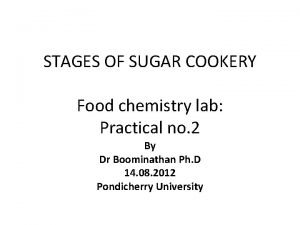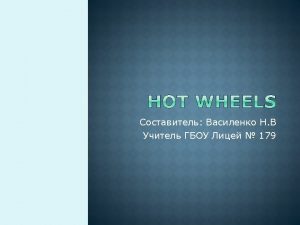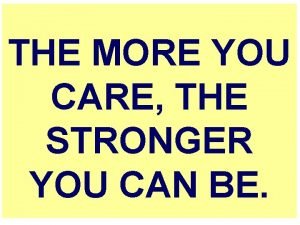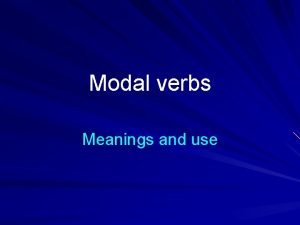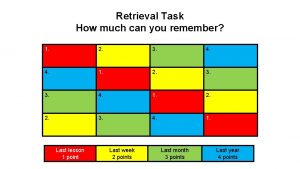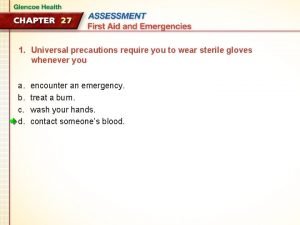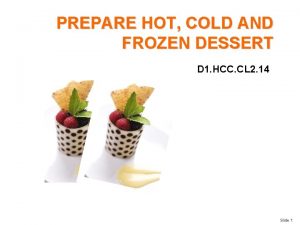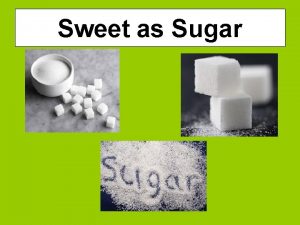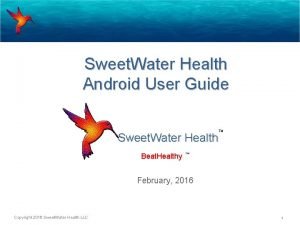Sugar isnt always so sweet What YOU can


































































- Slides: 66

Sugar isn’t always so sweet: What YOU can do to prevent pre-diabetes and maintain a healthy lifestyle Michael Randone Matthew Heesch Daniel Woodcock

Topics for today: q The hidden dangers of sugar drinks and treats q Diabetes q Healthy snack alternatives q Quick and easy workouts you can do anywhere

USDA Recommendations What is a "Healthy Diet"? The Dietary Guidelines describe a healthy diet as one that: � Emphasizes fruits, vegetables, whole grains, and fat-free or low-fat milk and milk products; � Includes lean meats, poultry, fish, beans, eggs, and nuts; and � Is low in saturated fats, trans fats, cholesterol, salt (sodium), and added sugars.

USDA Recommendations For a healthy diet, the average American should consume no more than: � 2, 000 -2, 500 calories a day � 271 g carbohydrates per day � 65 g total fats per day, including saturated fats (no more than 17 g) � 2, 300 mg sodium a day (1 tsp) � 32 g added sugars per day (8 -13 tsp)

Bad Fats These fats increase the risk of heart disease and raise cholesterol and weight Type of Bad Fat Food Source Saturated Fat Animal products, eggs, dairy, lard, butter, coconut and palm oils Trans Fat Hydrogenated veggie oils, commercial baked goods (cookies, crackers, cakes) fried foods, shortening, margarine Dietary Cholesterol Animal products (meat, poultry, seafood, eggs, dairy, lard, butter)

Healthy Fats Choose these instead to lower your risk of heart disease and cholesterol levels Type of Healthy Fat Food Source Monounsaturated Fat Olive oil, peanut oil, canola oil, avocado, nuts and seeds Polyunsaturated Fat Veggie oils (safflower, corn, sunflower, soy), nuts and seeds Omega-3 Fatty Acids Fatty, coldwater fish (salmon, mackerel, herring), flaxseeds, walnuts

Recommendations… � 10% of calories from sugar � 9 -13 teaspoons / day (based on 2, 000 calorie diet) �Currently 42. 5 teaspoons / day �Sugar shocker mix and match game

What are we eating!? � 25. 8 million children and adults in the United States— 8. 3% of the population— have diabetes. (2011 National Diabetes Fact Sheet ) � 200 years ago – 2 lbs / year � 1970 – 123 lbs / year � 2011 – 152 lbs / year �This equals 3 lbs (6 cups) a week!

What are we eating!? 4. 2 grams = 1 tsp of sugar � This is about the same as 1 cube of sugar. � � 6 -9 cubes of sugar is recommended intake

Sugar in Drinks �One cup (250 ml) of milk contains about 3 tsp of sugar �One cup (250 ml) of unsweetened fruit juice contains about 7 tsp of sugar. �Drinks with added sugar have more calories and don’t have the nutrients of milk and juice.

Soda 20 Years Ago 85 Calories 6. 5 ounces Today 250 Calories 20 ounces

Coca-Cola

Mountain Dew

Minute-Maid Orange Juice

Capri. Sun Pacific Cooler

Diabetes

What is Diabetes?

Diabetes �What is diabetes? �What causes it? �What are the symptoms? �What are the complications? �How can we prevent it?

What is Diabetes? �Group of metabolic diseases in which a person has chronic high blood sugar • Pancreas does not produce enough insulin • Cells do not respond to the insulin that is produced

Types of Diabetes �Type 1 Diabetes (DM 1) • Condition where body fails to produce insulin • Previously called Juvenile Diabetes • Usually diagnosed in children and young adults �Type 2 Diabetes (DM 2) • Condition where cells fail to use insulin properly • Previously called Adult Onset Diabetes • Most common form • Common complication of obesity • Most often diagnosed in adults, however this is changing

Types of Diabetes �Gestational Diabetes • Can appear during pregnancy • High blood glucose during pregnancy • High risk for DM 2 later in life �Pre-Diabetes (Metabolic Syndrome) • Comes before DM 2 • Blood glucose higher than normal, but not yet diabetes • You can have pre-diabetes and not know it

What Causes Diabetes? �Type 1 • Genetic disease �Partially inherited but needs an environmental trigger �Coxsackie B 4 virus • Unrelated to lifestyle

What Causes Diabetes? �Type 2 • Primarily due to lifestyle factors, but also genetics �Obesity (BMI > 30) �Lack of physical activity �Poor diet �Excess intake of sugary foods and drinks �Excess intake of saturated and trans fats �Stress �Urbanization

Type 2 continued �Genetic defects of β-cell function �Genetic defects in insulin processing or insulin action �Exocrine pancreatic defects �Endocrinopathies �Infections �Drugs

Risk Factors • A parent, brother or sister has diabetes • You are African American, Hispanic/Latino, Native American, Asian American or Pacific Islander • You had or were a baby weighing more than 9 pounds or had gestational diabetes • You have high blood pressure (over 140/90) • You have low HDL (good) cholesterol (40 or lower) • You have high triglycerides (150 or higher)


Diabetic Emergencies �Diabetic ketoacidosis (DM 1) �Results from shortage of insulin which causes the body to burn fatty acids producing acidic ketone bodies �Causes rapid deep breathing, nausea, vomiting, abdominal pain, altered consciousness and even death �Characterized by the fruity scent of acetone in breath � Hyperosmolar nonketotic state (DM 2) �High blood sugar causes sever dehydration which can lead to coma or death

Complications (acute) �Hypoglycemia • Abnormally low blood glucose • Caused by incorrectly timed insulin, incorrectly timed exercise, not enough food • Symptoms �Agitation �Excessive sweat �Weakness �Coma �Seizures �Death

Complications (acute) �Respiratory Infections • Immune response impaired in those with diabetes �Reduces function of immune cells and increases inflammation �Increased susceptibility to respiratory infections �Pneumonia �Influenza �Bronchitis

Complications (chronic) • Damage to blood vessels (angiopathy) �Microvascular disease �Cardiomyopathy �Nephropathy �Retinopathy �Amyotrophy �Macrovascular disease �Coronary artery disease �Myonecrosis �Peripheral vascular disease �Stroke

Complications (chronic) � Neuropathy • Abnormal and decreased sensation �Starts in feet but spreads to fingers and hands • Occurs in 15% of all patients • Precedes 84% of all lower leg amputations • Causes major increase in mortality rates

Diagnosing � How are diabetes and prediabetes diagnosed? � Diabetes • Fasting blood glucose of 126 mg/dl or higher � Pre-diabetes • Fasting blood glucose of 100 - 125 mg/dl

Preventing Diabetes �What is your fasting blood glucose? �When was your glucose last checked?

Get Checked �Get your blood glucose checked for pre-diabetes if you are • • • Age 45 or older and overweight Age 45 or older and not overweight – ask your doctor if you need to be tested Under age 45, but overweight and at increased risk for diabetes

Pre-diabetes �If you have pre-diabetes, what does it mean? • • You might get type 2 diabetes soon or sometime in the future You are more likely to get heart disease or have a stroke

Preventing Diabetes �Diabetes is serious �You will be healthier if you can delay or prevent diabetes �Diabetes �But, is common you can reduce your risk by losing weight

Preventing Diabetes � Delay or prevent type 2 diabetes with • Regular physical activity • Dietary changes • Weight loss

Losing 5 to 10% �How much do you weigh? much is 5 to 10% of your weight?

Losing 5 to 10% of Your Weight

Preventing Diabetes �Making sensible food choices • A series of books by the editors of Men’s Health Magazine • Highlights the good, bad, and the ugly in our current food culture • Presents several healthier options for popular convenience type foods

Baskin Robbins Heath Bar Shake You’ll go wild with this blend of Heath and Jamoca® ice creams, layered with chopped Heath Bar pieces and caramel, topped with whipped cream and more Heath Bar pieces.

The Most Unhealthy Drink on Earth Calories: 1, 420 Total Fat: 67 g (103% daily value) � Saturated Fat: 40 g (200% daily value) � Cholesterol: 180 g (60% daily value) � Sugar: 162 g � Additional preservatives, emulsifiers, and artificial colors and flavors � �

Outback Steakhouse Aussie Cheese Fries with Ranch Dressing Aussie Fries topped with melted Monterey Jack, Cheddar, bits of fresh chopped bacon and served with a spicy ranch dressing.

The Worst Food In America 2, 900 Calories 182 g fat 240 g carbs

Worst Burger Carl’s Jr Double Six Dollar Burger 1, 520 calories 111 g fat (The Low Carb Burger has just 490 calories. ) Worst Sweet Indulgence Cinnabon Classic Cinnamon Roll 813 calories 32 g fat (5 trans fat) 117 g carbs A Whopper has 150 fewer calories and 13 g more protein!

Worst Coffee Starbucks Venti Strawberries & Crème Frappucino 750 calories 120 g sugar (=more than 3 cans of soda) Worst Sandwich Quiznos Large Chicken Carbonara Sandwich 1, 510 calories 82 g fat 106 g carbs 3, 750 mg sodium

Worst Fast Food Chicken Meal Mc. Donalds Chicken Selects Premium Breast Strips with Ranch Sauce 830 calories 55 g fat 48 g carbs (Add fries and a soda=1, 710 cal) Better Alternative 20 Piece Chicken Mc. Nuggets with BBQ Sauce It will save you 530 calories!

Worst Drink Jamba Juice Chocolate Moo’d Power Smoothie 900 calories 10 g fat 183 g carbs 166 g sugar (= 2 pints Ben & Jerry’s Butter Pecan Ice Cream) Better Alternative Jamba Juice’s All Fruit Smoothies They have no added sugar. Always get the small 16 oz size!

Worst Crunchy Snack Gardetto’s Special Request Roasted Garlic Rye Chips 160 calories 10 g fat (2 g sat. fat, 2. 5 g trans) 40 mg sodium Fat equivalent=3 strips bacon Better Alternative Snyder’s Sourdough Nibblers (16 pieces) 120 Calories 0 g fat 100 mg sodium

Worst “Healthy” Snack Pop Tarts Whole Grain Brown Sugar Cinnamon (2 pastries) 400 calories 14 g fat (4 g saturated) 28 g sugar It may have whole grains, but it has as much sugar as a Snickers Better Alternative Sun-Maid Raisin English Muffins with Cinnamon (1 muffin) 170 calories 0. 5 g fat (1 g saturated) 13 g sugar 2 g fiber

Worst Cereal Quaker 100% Natural Granola, Oats, Honey & Raisins 420 calories 12 g fat (7 g saturated) 30 g sugar More sugar than Cocoa Pebbles! Calorie equivalent= 8 chicken wings! Better Alternative Kashi Go Lean 140 calories 1 g fat (0 saturated) 10 g fiber 6 g sugar 13 g protein

Eat This, Not That! Lets visit www. menshealth. com/eatthis For more examples

5 Hidden Dangers � CEREAL: Sugary cereals are essentially cookies. Trix and Lucky Charms have more sugar than ice cream bars. Watch for serving sizes when checking nutritional facts

5 Hidden Dangers � JUICE: Individually packed juices like Capri Sun and Sunny Delight are sugar water with token amounts of juice. Some have as much sugar as soda. Watch out for apple and grape juice (even 100% juice) which has lots of natural sugars. Orange and Cranberry are better.

5 Hidden Dangers � LUNCH SNACKS: Fruit snacks might as well be called gummy bears! With lots of high fructose corn syrup and preservatives, they’re a small step up from candy. Instead, send them off with string cheese, almonds, or PB and crackers

5 Hidden Dangers � BREAD: White bread, specifically, has loads of refined white flour and high-fructose corn syrup. Make sure to use whole grain breads with at least 3 g of fiber.

5 Hidden Dangers � VEGETABLES: Not the veggies, but the toppings. When you smother veggies with cheese or ranch dressing, you’re getting tons of saturated fats. Try steaming, roasting, or sautéing when possible

EAT THIS, NOT THAT Rules to Live By � � EAT WHOLE FOODS! An apple is better for you than 100% apple juice (more fiber)! If you’re going to eat Mac & Cheese, get something that uses real cheese or (better yet) make it yourself! Eat whole grains like whole wheat, quinoa, oats, buckwheat, corn, and rice.

EAT THIS, NOT THAT Rules to Live By � � STAY AWAY FROM PROCESSED! Most fast food is highly processed! If you can’t identify all the ingredients on the label, it’s probably processed. In the supermarket, try to get most of your foods on the perimeter. That’s usually where the dairy, meats, and produce are located.

EAT THIS, NOT THAT Rules to Live By � � � BE AWARE OF YOUR BODY! Counting calories and fat grams isn’t for everyone, but you should know what you’re putting in your body and keep track of it daily. Pay attention to your body’s reaction to foods. Does it give you energy and make you crash? Does it make you feel bloated and sluggish? Maybe it’s what you ate today!

Importance of Physical Activity

National Trends Currently in the United States*. . . • 64% of adults are overweight • 30% of adults are obese • 17% of children age 6 -18 are overweight • Obesity is the leading cause of unnecessary deaths, and those who are overweight or obese run a greater risk for such ailments as cardiovascular disease and diabetes *according to the Centers for Disease Control and Prevention www. cdc. gov

Body Mass Index � A simple way to asses your risk is to calculate your body mass index (BMI) � BMI can be calculated by taking your weight ( in lbs) divided by your height (in inches) squared, multiplied by 703. � Ex. Someone who is 6 ft 1 inch (73 in) and 170 lbs has a BMI of 22. 4 � You can also use the CDC’s online BMI calculator found at http: //www. cdc. gov/healthyweight/assessing/bmi/adult_bmi/english_bmi_cal culator/bmi_calculator. html A BMI below 18. 5 is considered “Underweight” 18. 5 -24. 9 is considered “Normal” 25. 0 -29. 9 is considered “Overweight” 30. 0 and above is considered “Obese” � �

The importance of physical activity � Regular physical activity has been shown to maintain weight, reduce high blood pressure, reduce risk for type 2 diabetes, heart attack, stroke, and many forms of cancer, and reduce symptoms of depression and anxiety � The American College of Sports Medicine recommends 150 minutes of moderate-intensity or 75 minutes of vigorous-intensity physical activity per week in order to maintain weight � For weight loss, 300 minutes of moderate-intensity or 150 minutes of vigorous-intensity physical activity per week is suggested

The importance of physical activity � Examples of moderate-intensity physical activity include: - brisk walking - light yardwork - light snow shoveling - riding a bike at a casual pace � Examples of vigorous-intensity physical activity include: - running or jogging - lap swimming - cross-country skiing - team sports such as football or basketball

The importance of physical activity “Exercise is Medicine” – 23 ½ Hours Video http: //www. youtube. com/watch? v=a. Ua. In. S 6 HIGo
 Sweet heavenly dove
Sweet heavenly dove There isn't any
There isn't any Notch glaucoma
Notch glaucoma Isnt the love of jesus something wonderful
Isnt the love of jesus something wonderful Not being fair quotes
Not being fair quotes Isnt he beautiful
Isnt he beautiful If you think you can you can poem
If you think you can you can poem What is alliteration in song
What is alliteration in song Jared peet
Jared peet Source to sink plants
Source to sink plants Labeled vascular bundle
Labeled vascular bundle Reducing sugar vs non reducing sugar
Reducing sugar vs non reducing sugar Stages of sugar cookery pdf
Stages of sugar cookery pdf Bial's test reagent
Bial's test reagent If you can imagine it you can achieve it
If you can imagine it you can achieve it If you cant measure it you cant manage it
If you cant measure it you cant manage it If you can't measure it you can't control it
If you can't measure it you can't control it Can't manage what you don't measure
Can't manage what you don't measure Vertikale bilanzkennzahlen
Vertikale bilanzkennzahlen Gives you wings slogan
Gives you wings slogan Low prices always
Low prices always When you infer, you always ________.
When you infer, you always ________. You become what you always were a very big fish
You become what you always were a very big fish Wherever you lead i will follow
Wherever you lead i will follow Sugar glider cannibalism
Sugar glider cannibalism You can tell harris about it just ____(easily) as i can.
You can tell harris about it just ____(easily) as i can. You can tell harris about it just ____(easily) as i can.
You can tell harris about it just ____(easily) as i can. Positive degree examples
Positive degree examples Through you i can do anything
Through you i can do anything Specific heat capacity of sugar
Specific heat capacity of sugar You can't turn right
You can't turn right So you think you can argue
So you think you can argue Standardasation
Standardasation Alan and susie an argument
Alan and susie an argument Go straight turn left
Go straight turn left You can be just the one you wanna be
You can be just the one you wanna be I can hear you quite well. you not shout
I can hear you quite well. you not shout So you think you can argue
So you think you can argue Check if you can remember what tim tells you
Check if you can remember what tim tells you Epping forest community church
Epping forest community church An inspector calls context timeline
An inspector calls context timeline What do you always/usually/often/sometimes
What do you always/usually/often/sometimes You may cross the barren desert
You may cross the barren desert We'll always care about you
We'll always care about you What is peer editing
What is peer editing You should always seek professional medical care for
You should always seek professional medical care for The kite runner title significance
The kite runner title significance It always takes longer than you think
It always takes longer than you think Types of microscopes
Types of microscopes Types of microscopes
Types of microscopes Answering questions in spanish
Answering questions in spanish Elvis you are always on my mind
Elvis you are always on my mind When focusing a specimen you should always start with the
When focusing a specimen you should always start with the Microscope
Microscope Low i am with you always
Low i am with you always Peace be with you always
Peace be with you always What are 4 types of microscopes?
What are 4 types of microscopes? Do you love the rain
Do you love the rain Eat meals that are nutritious agree or disagree
Eat meals that are nutritious agree or disagree Tell me what you eat and i shall tell you what you are
Tell me what you eat and i shall tell you what you are What is the mood of the treasure of lemon brown
What is the mood of the treasure of lemon brown Earths biomes
Earths biomes Node_latest_armhf.deb
Node_latest_armhf.deb Genus of sweet potato
Genus of sweet potato Hot and cold
Hot and cold Vohland v sweet
Vohland v sweet Sweet ambiguity ch.1
Sweet ambiguity ch.1












